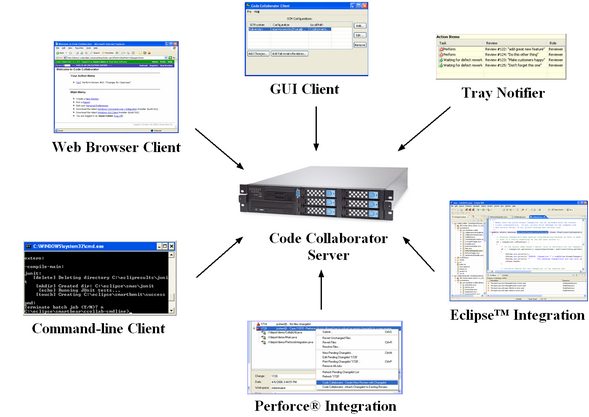Code Collaborator includes a server component, and a variety of clients, 3rd-party integrations, and client protocols.

As with most enterprise-class software systems, a server process acts as the hub, manager, and controller of information. The server has a web-based user interface where users and administrators can do everything — create and perform reviews, configure personal and system-wide settings and run reports. The server uses an external database to store all data and configuration.
The web browser client is used by entering an external URL in a web browser to connect to the Code Collaborator server. This is where most of the review will take place, where you edit, view, configure the reviews. The web interface supports Internet Explorer, Safari and FireFox.
Developers will typically install the cross-platform client. This tool includes a Command Line Client that lets you upload local files (and file-changes) into new and existing reviews. The Command Line Client also includes scripting commands for implementing custom behavior and integrating with external systems.
There are many reasons why you might want to integrate Code Collaborator with other systems. An issue-tracker integration point might let you synchronize Code Collaborator "defects" with issue-tracker "issues," or you might want to mirror review data (metrics/comments/file-differences) into the associated ticket. A reporting integration point might let you mirror Code Collaborator metrics into your existing reporting system (examples: defects/kLOC, defects/man-hour, kLOC/man-hour, number of defects found of different types or severities, etc).
The cross-platform client install includes a graphical client to complement the web-based user interface already provided by the server. The GUI client is a cross-platform client available for Windows, Mac, and Unix/Linux users.
In addition to uploading files, the GUI Client gives you a taskbar icon that updates to show you whether you have any pending tasks in Code Collaborator. This is called the Tray Notifier and is available to Windows and Unix/Linux users. This allows users to easily access pertinent reviews and alerts the user of any new activity in reviews without being actively involved in the web browser client.
Perforce users will probably want to install the Perforce Client Integration tools. These are included in the client installer.
Integration with P4V and P4Win lets developers upload changelists into new or existing reviews just by right-clicking on the changelist. This works on both "pending" and "submitted" changelists.
We also supply a special tool for use as a Perforce server trigger. For example, you can use this to enforce a rule like "Every submit on this branch requires a review." You can also use this to automatically upload all submitted changelists into Code Collaborator so that you can review code after it has been checked in. This can be especially useful with off-shore development groups.
The Eclipse Plug-in gives users the ability to upload files and perform reviews from within any Eclipse-based application. A variety of applications are supported.